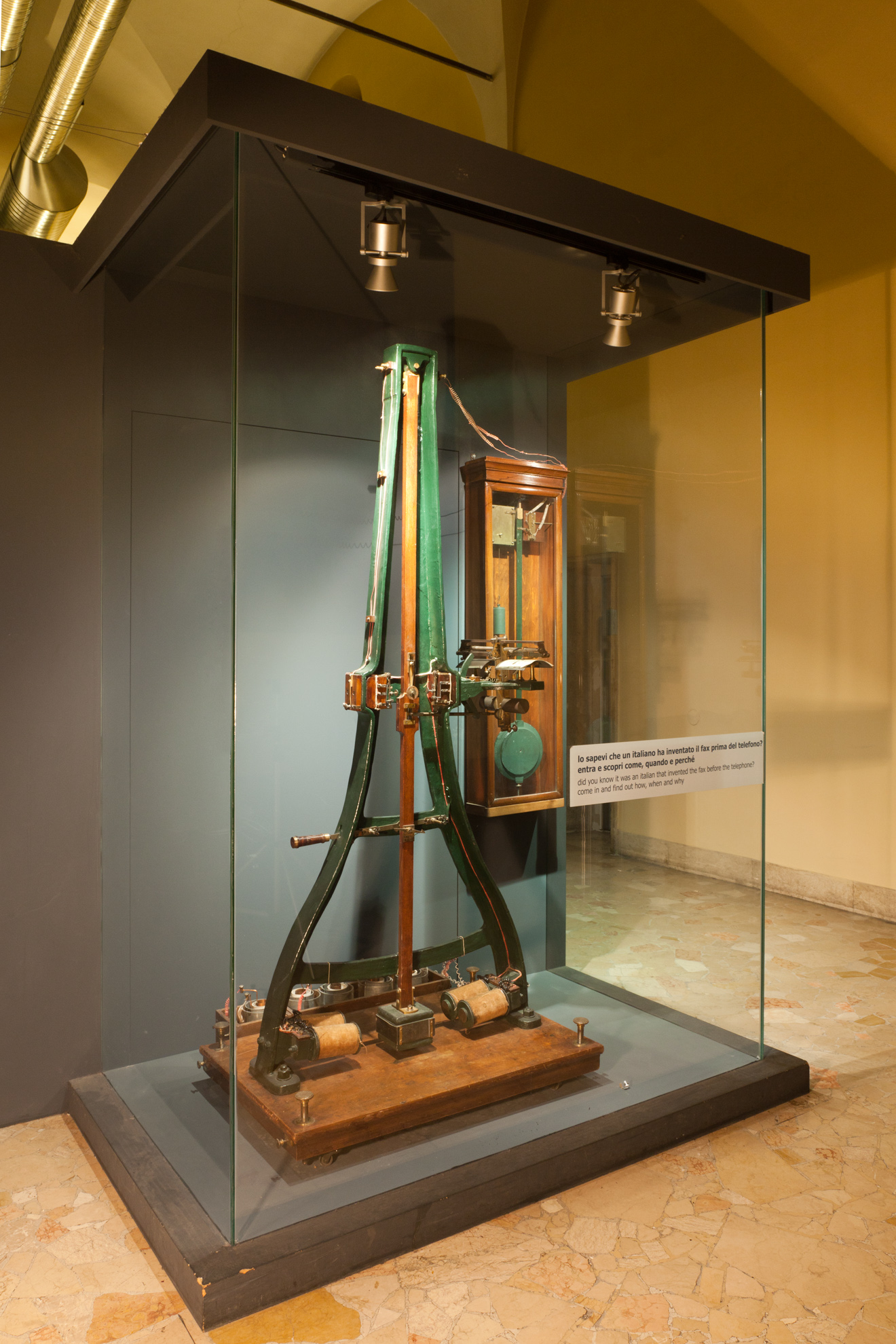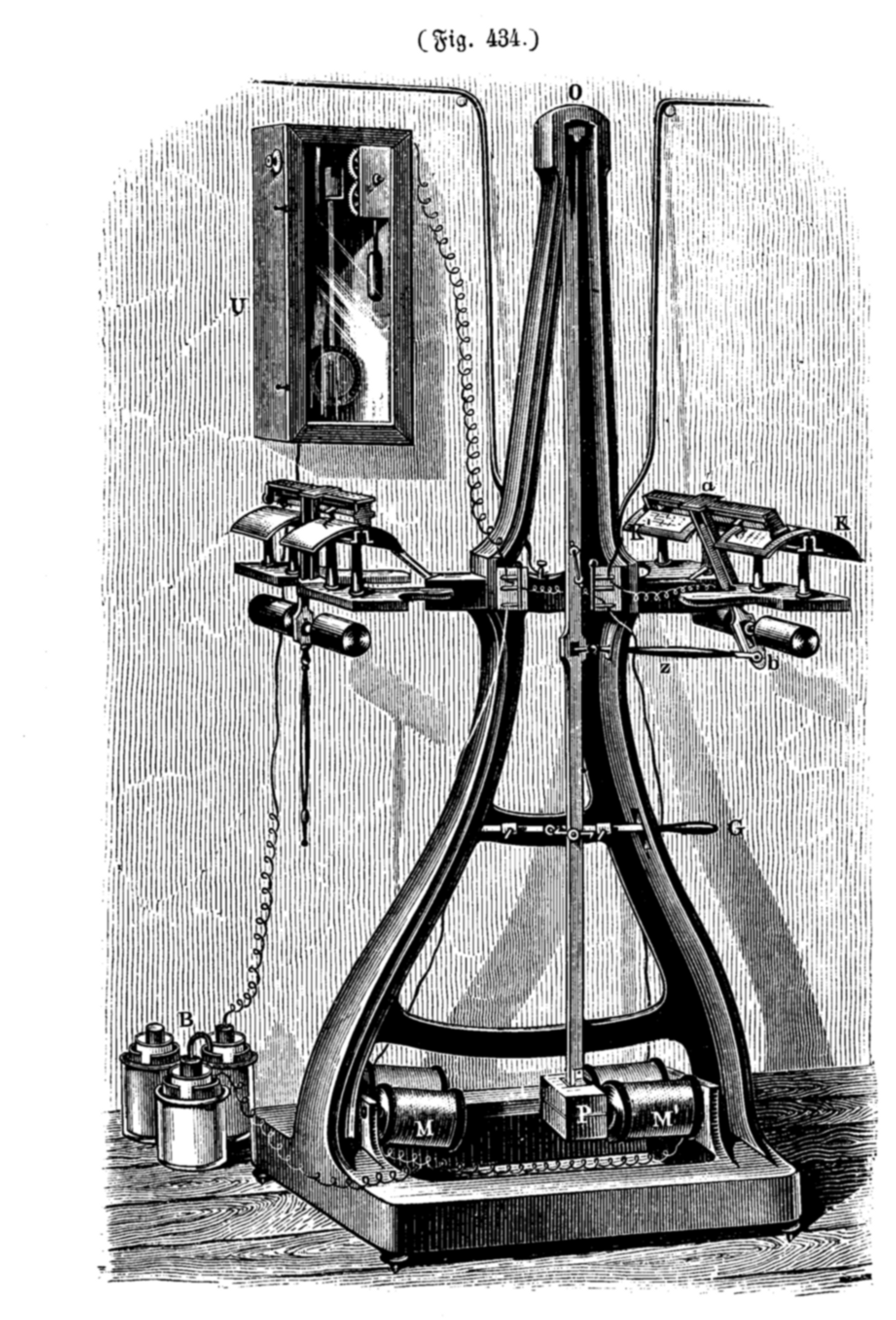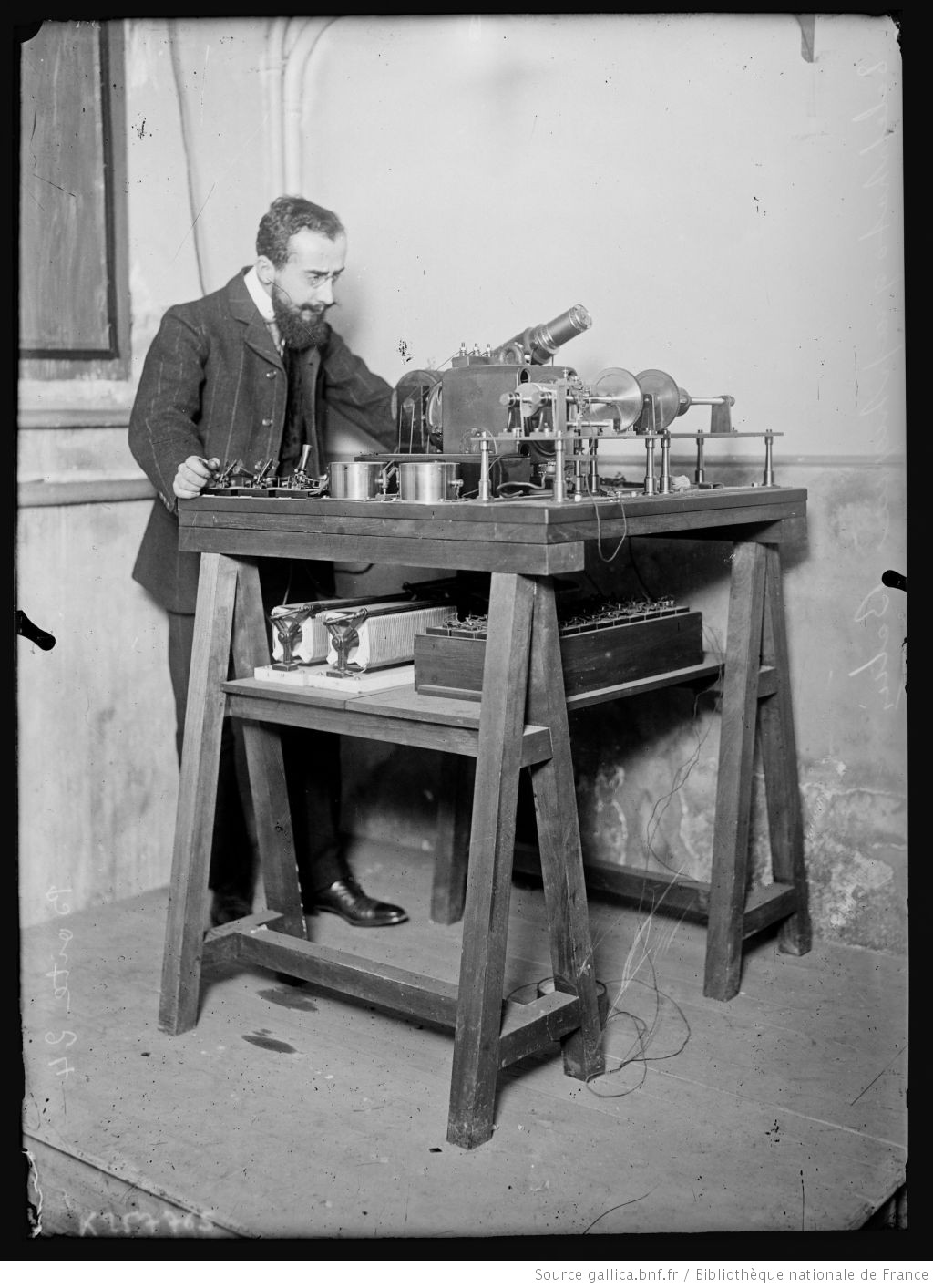|
Fax
Fax (short for facsimile), sometimes called telecopying or telefax (the latter short for telefacsimile), is the telephonic transmission of scanned printed material (both text and images), normally to a telephone number connected to a printer or other output device. The original document is scanned with a fax machine (or a telecopier), which processes the contents (text or images) as a single fixed graphic image, converting it into a bitmap, and then transmitting it through the telephone system in the form of audio-frequency tones. The receiving fax machine interprets the tones and reconstructs the image, printing a paper copy. Early systems used direct conversions of image darkness to audio tone in a continuous or analog manner. Since the 1980s, most machines modulate the transmitted audio frequencies using a digital representation of the page which is compressed to quickly transmit areas which are all-white or all-black. Fax machines were ubiquitous in office environments in t ... [...More Info...] [...Related Items...] OR: [Wikipedia] [Google] [Baidu] |
Radiofax
Radiofacsimile, radiofax or HF fax is an analogue mode for transmitting monochrome images via high frequency (HF) radio waves. It was the predecessor to slow-scan television (SSTV). It was the primary method of sending photographs from remote sites (especially islands) from the 1930s to the early 1970s. It is still in limited use for transmitting weather charts and information to ships at sea. History Richard H. Ranger, an electrical engineer working at Radio Corporation of America (RCA), invented a method for sending photographs through radio transmissions. He called his system the wireless photoradiogram, in contrast to the fifty-year-old telefacsimile devices which used first telegraphic wires, and then later was adapted to use the newer telephone wires. On 29 November 1924, Ranger's system was used to send a photograph from New York City to London. It was an image of President Calvin Coolidge and was the first transoceanic radio transmission of a photograph. Also that ye ... [...More Info...] [...Related Items...] OR: [Wikipedia] [Google] [Baidu] |
Giovanni Caselli
Giovanni Caselli (8 June 1815 – 25 April 1891) was an Italian priest, inventor, and physicist. He studied electricity and magnetism as a child which led to his invention of the pantelegraph (also known as the universal telegraph or all-purpose telegraph), the forerunner of the fax machine. The world's first practical operating facsimile machine ("fax") system put into use was by Caselli. He had worldwide patents on his system. His technology idea was further developed into today's analog television. Caselli was a student and professor at the University of Florence in Italy. He started a technical journal that explained physics in layman's terms. For his pantelegraph technology he was awarded the Legion of Honor by Napoleon III of France. Parisian scientists and engineers started the Pantelegraph Society to exchange ideas about the pantelegraph and the associated synchronizing apparatus, in order to get the sending and receiving mechanisms to work together properly. Early l ... [...More Info...] [...Related Items...] OR: [Wikipedia] [Google] [Baidu] |
Telautograph
The telautograph is an analog precursor to the modern fax machine. It transmits electrical impulses recorded by potentiometers at the sending station to servomechanisms attached to a pen at the receiving station, thus reproducing at the receiving station a drawing or signature made by the sender. It was the first such device to transmit drawings to a stationary sheet of paper; previous inventions in Europe had used rotating drums to make such transmissions. Invention The telautograph's invention is attributed to Elisha Gray, who patented it on July 31, 1888. Gray's patent stated that the telautograph would allow "one to transmit his own handwriting to a distant point over a two-wire circuit." It was the first facsimile machine in which the stylus was controlled by horizontal and vertical bars. The telautograph was first publicly exhibited at the 1893 World's Columbian Exposition held in Chicago. While the patent schema's geometry implies vertical and horizontal coordinat ... [...More Info...] [...Related Items...] OR: [Wikipedia] [Google] [Baidu] |
Telegram
Telegraphy is the long-distance transmission of messages where the sender uses symbolic codes, known to the recipient, rather than a physical exchange of an object bearing the message. Thus flag semaphore is a method of telegraphy, whereas pigeon post is not. Ancient signalling systems, although sometimes quite extensive and sophisticated as in China, were generally not capable of transmitting arbitrary text messages. Possible messages were fixed and predetermined and such systems are thus not true telegraphs. The earliest true telegraph put into widespread use was the optical telegraph of Claude Chappe, invented in the late 18th century. The system was used extensively in France, and European nations occupied by France, during the Napoleonic era. The electric telegraph started to replace the optical telegraph in the mid-19th century. It was first taken up in Britain in the form of the Cooke and Wheatstone telegraph, initially used mostly as an aid to railway signallin ... [...More Info...] [...Related Items...] OR: [Wikipedia] [Google] [Baidu] |
Alexander Bain (inventor)
Alexander Bain (12 October 1810 – 2 January 1877) was a Scottish inventor and engineer who was first to invent and patent the electric clock. He invented the Telegraph Clock, which was a technology of synchronizing many electric clocks placed anywhere in the world; they would all have the exact same time. He also invented and patented the technology of the facsimile machine for scanning images and transmitting them across telegraph lines hundreds of miles away. He installed the railway telegraph lines between Edinburgh and Glasgow, Scotland, for recording messages, to regulate the safe movement of trains, marking time, giving signals, and printing information at different locations. He invented a chemical telegraph technology of being able to transmit across a telegraph line messages at up to 1000 words per minute, while at the time Morse's telegraph could only produce 40 words a minute. Early life Bain was born in Houstry, near Watten, Caithness, Scotland. He was born o ... [...More Info...] [...Related Items...] OR: [Wikipedia] [Google] [Baidu] |
Pantelegraph
The pantelegraph (Italian: ''pantelegrafo''; French: ''pantélégraphe'') was an early form of facsimile machine transmitting over normal telegraph lines developed by Giovanni Caselli, used commercially in the 1860s, that was the first such device to enter practical service. It could transmit handwriting, signatures, or drawings within an area of up to . Description The pantelegraph used a regulating clock with a pendulum which made and broke the current for magnetizing its regulators, and ensured that the transmitter's scanning stylus and the receiver's writing stylus remained in step. To provide a time base, a large pendulum was used weighing , mounted on a frame high. Two messages were written with insulating ink on two fixed metal plates; one plate was scanned as the pendulum moved to the right and the other as the pendulum moved to the left, so that two messages could be transmitted per cycle. The receiving apparatus reproduced the transmitted image by means of paper impre ... [...More Info...] [...Related Items...] OR: [Wikipedia] [Google] [Baidu] |
Wirephoto
Wirephoto, telephotography or radiophoto is the sending of pictures by telegraph, telephone or radio. Édouard Belin's Bélinographe of 1913, which scanned using a photocell and transmitted over ordinary phone lines, formed the basis for the Wirephoto service. In Europe, services similar to a wirephoto were called a Belino. Western Union transmitted its first halftone photograph in 1921. AT&T followed in 1924, and RCA sent a ''Radiophoto'' in 1926. The Associated Press began its Wirephoto service in 1935 and held a trademark on the term ''AP Wirephoto'' between 1963 and 2004. The first AP photo sent by wire depicted the crash of a small plane in New York's Adirondack Mountains. Technologically and commercially, the wirephoto was the successor to Ernest A. Hummel's Telediagraph of 1895, which had transmitted electrically scanned shellac-on-foil originals over a dedicated circuit connecting the '' New York Herald'' and the '' Chicago Times Herald'', the ''St. Louis Republic'', ... [...More Info...] [...Related Items...] OR: [Wikipedia] [Google] [Baidu] |
Arthur Korn
Arthur Korn (20 May 1870 – 21 December/22 December 1945) was a German physicist, mathematician and inventor. He was involved in the development of the fax machine, specifically the transmission of photographs or telephotography, known as the Bildtelegraph, related to early attempts at developing a practical mechanical television system. Life Born in Breslau, Korn was the son of a Jewish couple, Moritz and Malwine Schottlaender. He attended gymnasia in Breslau and Berlin. He then studied physics and mathematics in Leipzig at the age of 15, from where he graduated in 1890. Afterwards, he studied in Berlin, Paris, London and Würzburg. In 1895, he became a lecturer in law at the University of Munich, and was appointed professor in 1903. In 1914, he accepted the chair of physics at the Berlin Institute of Technology. Dr. Korn, being of Jewish descent, was dismissed from his post in 1935 with the rise of the Nazi Party. In 1939 he left Germany with his family and moved to the ... [...More Info...] [...Related Items...] OR: [Wikipedia] [Google] [Baidu] |
Spark Printer
Spark printing is an obsolete form of computer printing and before that fax and chart recorder printing which uses a special paper coated with a conductive layer over a contrasting backing, originally black carbon over white paper but later aluminium over black paper. Printing on this paper uses pulses of electric current to burn away spots of the conductive layer. Typically, one or more electrodes are swept across the page perpendicular to the direction of paper motion to form a raster of potential burnt spots. Western Union developed the paper for this printing technology in the late 1940s, under the trademark "Teledeltos". The Western Union "Deskfax" fax machine, announced in 1948, was one of the first printers to use this technology. Spark printing was a simple and inexpensive technology. The print quality was relatively poor, but at a time when conventional printers cost hundreds of pounds, spark printers' sub-£100 price was a major selling point. The other major dow ... [...More Info...] [...Related Items...] OR: [Wikipedia] [Google] [Baidu] |
Western Union
The Western Union Company is an American multinational financial services company, headquartered in Denver, Colorado. Founded in 1851 as the New York and Mississippi Valley Printing Telegraph Company in Rochester, New York, the company changed its name to the Western Union Telegraph Company in 1856 after merging with several other telegraph companies. The company dominated the American telegraphy industry from the 1860s to the 1980s, pioneering technology such as telex and developing a range of telegraph-related services (including wire money transfer) in addition to its core business of transmitting and delivering telegram messages. After experiencing financial difficulties, Western Union began to move its business away from communications in the 1980s and increasingly focused on its money transfer services. The company ceased its communications operations completely in 2006, at which time The New York Times described it as "the world's largest money-transfer business" ... [...More Info...] [...Related Items...] OR: [Wikipedia] [Google] [Baidu] |
Shelford Bidwell
Shelford Bidwell FRS (6 March 1848 – 18 December 1909) was an English physicist and inventor. He is best known for his work with "telephotography", a precursor to the modern fax machine. Private life He was born in Thetford, Norfolk the eldest son of Shelford Clarke Bidwell, a brewer, and his wife Georgina, the daughter of George Bidwell of Stanton, Norfolk. He entered Caius College, Cambridge, graduating BA (1870), MA (1873) and LLB (1873). Called to the bar from Lincoln's Inn in 1873, he practised as a barrister on the South Eastern Circuit for several years before becoming interested in electronics. He married in 1874 Anna Wilhelmina Evelyn, daughter of Edward Firmstone, rector of Wyke (Regis), the mother church of Weymouth who lived much of later life with his family in Winchester to be close to Winchester Cathedral. Bidwell was the head of a wealthy Victorian family from 1881 to at least 1901, having five servants, at Riverstone, Wimbledon Park Road, Southfiel ... [...More Info...] [...Related Items...] OR: [Wikipedia] [Google] [Baidu] |
Elisha Gray
Elisha Gray (August 2, 1835 – January 21, 1901) was an American electrical engineer who co-founded the Western Electric Manufacturing Company. Gray is best known for his development of a telephone prototype in 1876 in Highland Park, Illinois. Some recent authors have argued that Gray should be considered the true inventor of the telephone because Alexander Graham Bell allegedly stole the idea of the liquid transmitter from him. Although Gray had been using liquid transmitters in his telephone experiments for more than two years previously, Bell's telephone patent was upheld in numerous court decisions. Gray is also considered to be the father of the modern music synthesizer, and was granted over 70 patents for his inventions. He was one of the founders of Graybar, purchasing a controlling interest in the company shortly after its inception. Biography and early inventions Gray was born in Barnesville, Ohio, the son of Christiana (Edgerton) and David Gray. His family w ... [...More Info...] [...Related Items...] OR: [Wikipedia] [Google] [Baidu] |











